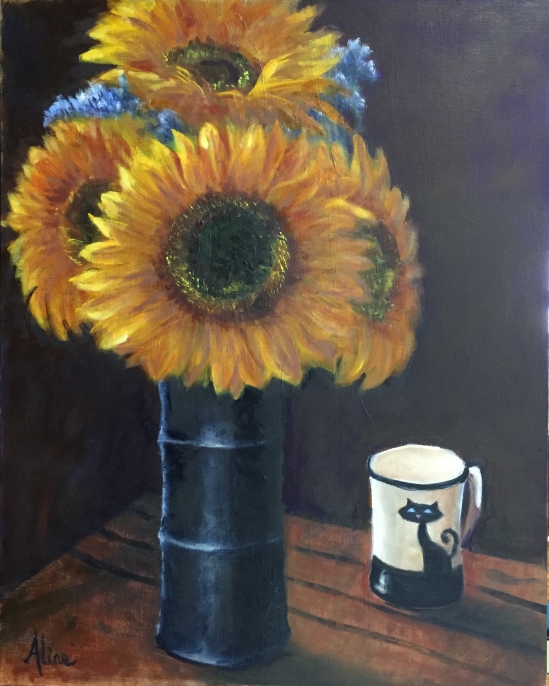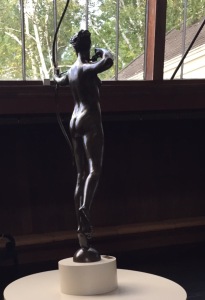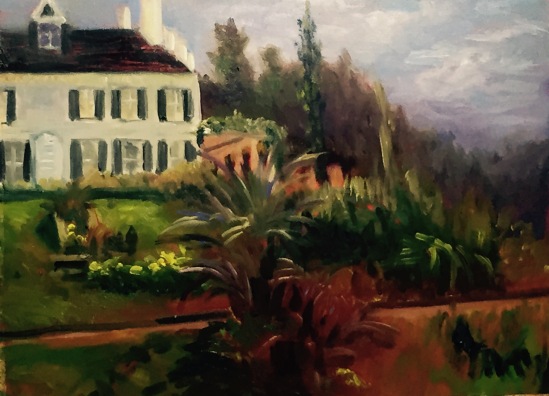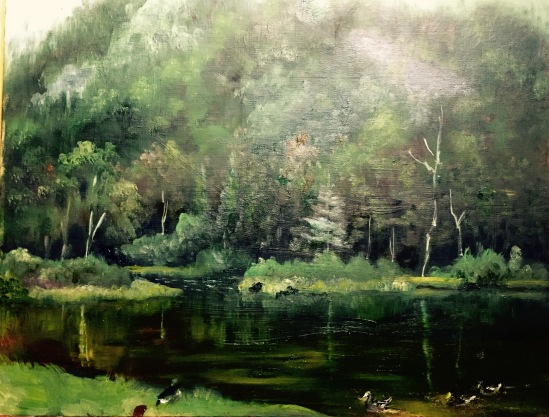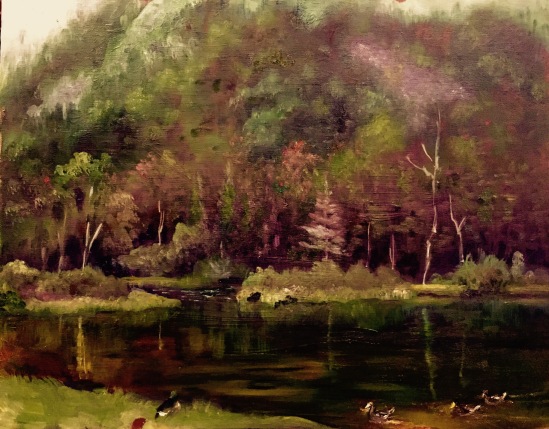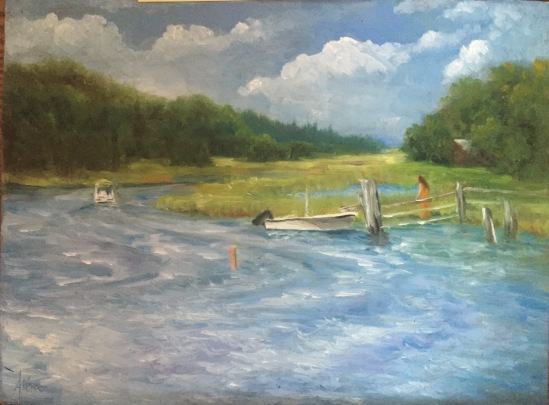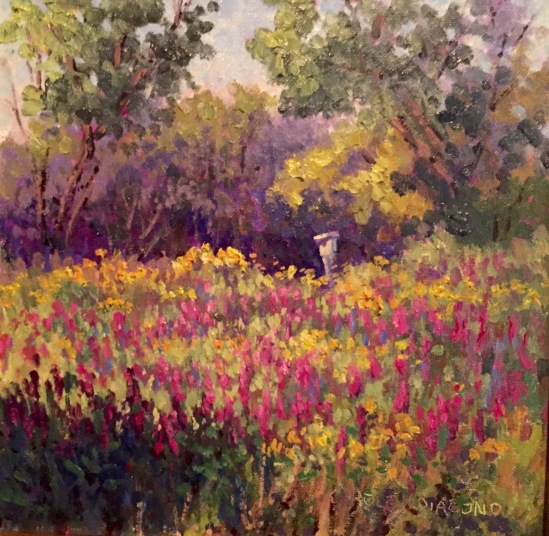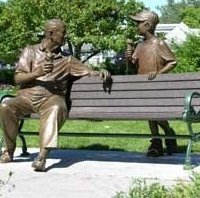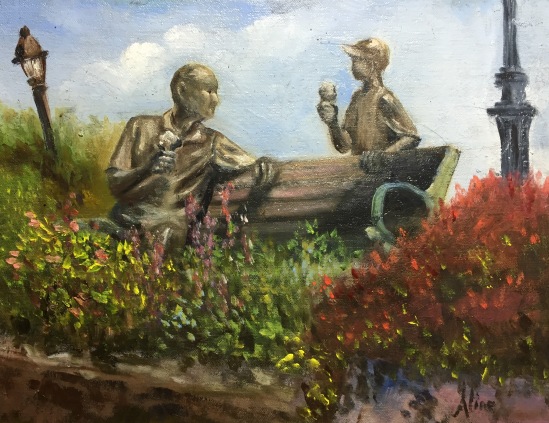This bouquet of Sunflowers and small blue companions was a gift from another artist (thanks, again, Flo) for whom I was doing a small favor. I started the painting the same day that I received them, when the flowers were fresh, but it took me a few weeks to finish i; the flowers had all died in the meantime. So this painting is from both life and from memory. My tea mug just happened to be there when I started, and it filled a compositional need, so it got to stay. The blue of the companion flowers is picked up in the cat’s eyes on the mug. No, I sure don’t know the name of the companion blue flowers.
What is it about sunflowers that makes an artist want to paint them? Their sunny color, their sunny symbolism, their over-the-top size are all hard to resist, but I was also drawn to the complexity and variety of the brownish, greenish centers of the flowers. Until I had a bunch of them in my hands and could examine them close up, I never realized that the centers were variable in color and have quite a lot going on, design-wise.
My sunflowers were mostly dark brown in the center, but on the periphery of the center, little green and yellow shoots were pushing through the brown matrix. Gosh, I really need to find out what all that stuff is, and what it is called. Excuse me, I’m off to Wikipedia to learn.
OK, I’m back, more confused than ever. But I gleaned that the yellow petals are called the ray florets and are not really the flower of the thing. The flowers are the tiny rosettes that grow from the brown matrix. Wikipedia kindly provided this picture isolating the flowers from the (dead) ray florets.
An even more intriguing statement is this one: “Sunflowers are especially well known for their symmetry based on Fibonacci numbers and the Golden angle.” If ever there was a secret formula for attracting artists, that has to be it. Thank god I finished the painting before I was made aware of this aspect, or I would have got hung up on the idea of depicting the Fibonacci sequence and Golden angle, which are present in the way the rosettes swirl from the center outward, in a closely knit spiral. Here it is, simplified:
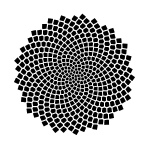 I don’t really understand how those two math concepts produce the sunflower design, and I’m so glad I don’t have to understand it as it was beginning to make my head hurt. Here’s a website on the subject that you might enjoy. Or not.
I don’t really understand how those two math concepts produce the sunflower design, and I’m so glad I don’t have to understand it as it was beginning to make my head hurt. Here’s a website on the subject that you might enjoy. Or not.
My Sunflower Bouquet is for sale. It is painted on a 20×16 stretched canvas and I am asking $925 for it, unframed.
Aline Lotter is currently exhibiting:
At the Bartlett Inn in Bartlett; at the Bernerhof Inn in Glen; at the Red Jacket Inn in North Conway; and at the law offices of Mesmer and Deleault at 41 Brook St in Manchester. For the month of October I have two paintings in the Womens Club of Concord, part of a three-part 20th anniversary exhibit by the Womens Caucus for Art. However, the hours during which the WCC is accessible to the public are unpredictable. You can visit another of the 20th Anniversary exhibits at the Kimball Jenkins carriage house through the month of November.
Opening this week, with a reception Friday night, 5-7, is the 2015 Regional Juried Show of the Center for the Arts in the New London Inn. Also on Friday night, 7-9, is the reception for the Womens Caucus for Art annual 6×6 exhibit at Apotheca, in Goffstown, NH. Opening this week as part of NH Open Doors is another popup from East Colony Fine Art: at Salzburg Square in Amherst, NH, Thursdays through Sundays, 11-5, from now until the day before Christmas. This Sunday, as part of the NH Open Doors, I will be painting a demo at the store.
As usual, you may view paintings with prices and order prints, iPhone cases and the like at my Fine Art America page. If the painting you are interested in is not there, or if you prefer to bypass that experience, you may contact me by email to alotter@mac.com.
If you want to add a public comment to this blog, go to the bottom of this page where it says “Leave a Reply”, and enter your comment in that box. I love to get public comments, so don’t be shy!

